France was one of the early countries to be significantly impacted by the coronavirus pandemic currently gripping the world. After a worrying rise in cases, the country entered lockdown on 17 March, a situation that would last eight weeks. Since 11 May, things have been progressively opening up, although some restrictions remain in place. After recent rises in the number of cases, experts fear a second wave could be on its way, and are preparing for possible localised lockdowns in affected areas.
In the meantime, like many other cities, Paris has been forced to adapt to the situation. The local government has proven capable, mounting a quick response with a number of key measures. Let’s take a look at a few of these.
Masks and hand gel
The national government mandated masks on public transport as soon as lockdown was first lifted on 11 May, and made them compulsory in all enclosed public spaces on Monday 20 July. The city of Paris acted early to make sure that every Parisian resident could have one cloth mask free of charge, to be collected from a local pharmacy. However, not all of the 2.2 million masks ultimately made available were ready by 11 May.

Meanwhile, hand gel dispensers have been installed around the city, including at 1500 bus shelters (three-quarters of the total number) and all 435 of Paris’s self-cleaning toilets. In some parks, attached towater fountains, liquid soap has been provided; this is especially aimed at young children, for whom alcohol gel is not recommended.
Restaurant and bar terraces
When restaurants and cafés first reopened across France on 2 June, the Paris region was still classified as an “orange zone”, indicating a higher alert level than the green zone covering most of the country. As such, Parisian restaurants were only allowed to open for outdoor dining. While outdoor seating is quite common here, only some establishments have sufficient space on the pavement for this, so under the standard rules many would have been obliged to remain completely closed. While some restaurants could offer takeaway, this is not a viable option for many cafés and bars.
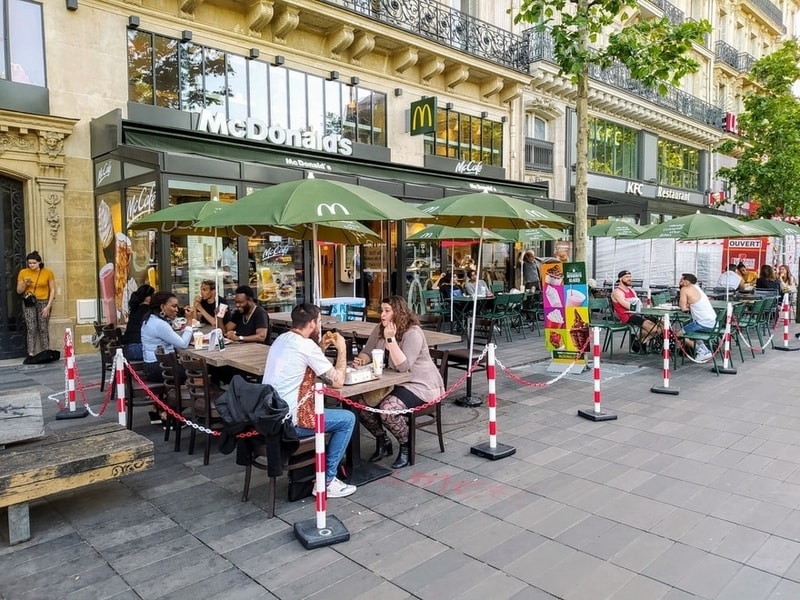
To address this problem, the local government allowed restaurants to invade the street. Until 30 September, limits on pavement terraces have been dramatically relaxed, and a greatly simplified procedure has been put in place for requesting permission. More radically, parking spaces and delivery spots have been removed to make room. This is in line with the overarching theme of both mayor Anne Hidalgo’s first term in office and her successful reelection campaign this year: reducing the place of the private car. Entire stretches of some streets have been closed to motor traffic for parts of the day, allowing tables to occupy almost the full width of the road.
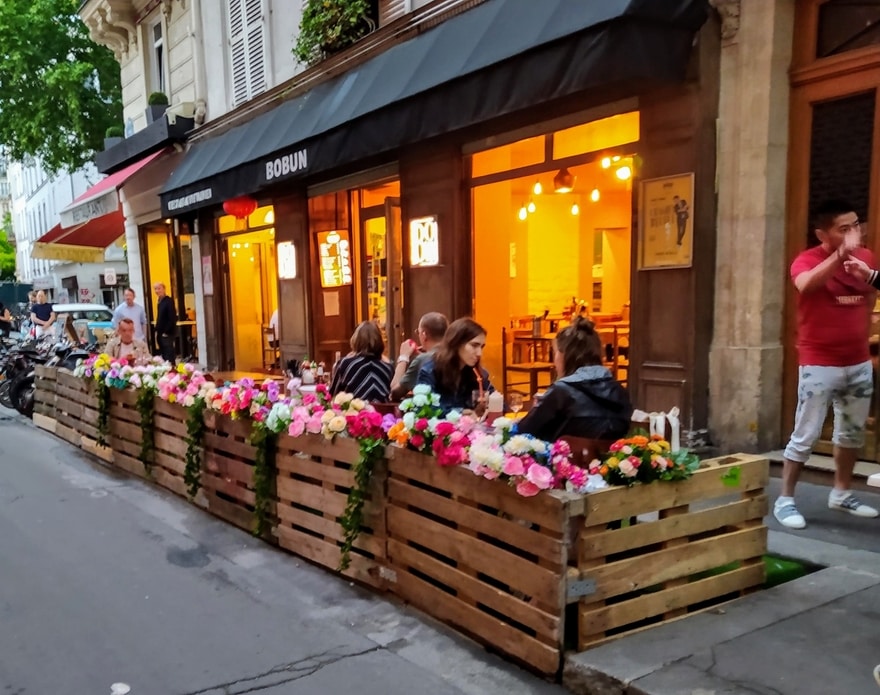
On 15 June, restaurants were allowed to reopen indoors, but increased distances between tables mean that the extra terraces remain important. These spaces have massively developed since the beginning of the period. At first, many outdoor seating areas were mere collections of tables and chairs hastily placed outside. Now, many have added fences, plants and other decorations, and platforms to ensure parking space terraces are flush with the pavement. I documented this for several weeks in my neighbourhood in a Twitter thread.
Café and restaurant culture is important to Parisians, and the silence and appearance of shuttered tea rooms and boarded-up bistros was surreal to witness during the lockdown. As such, many locals have welcomed the new initiative, people-watching over their morning espresso, enjoying happy hour drinks with friends and colleagues they hadn’t seen for weeks, and dining under the sun. The efforts of many restaurateurs to beautify these spaces have made them all the more appealing.
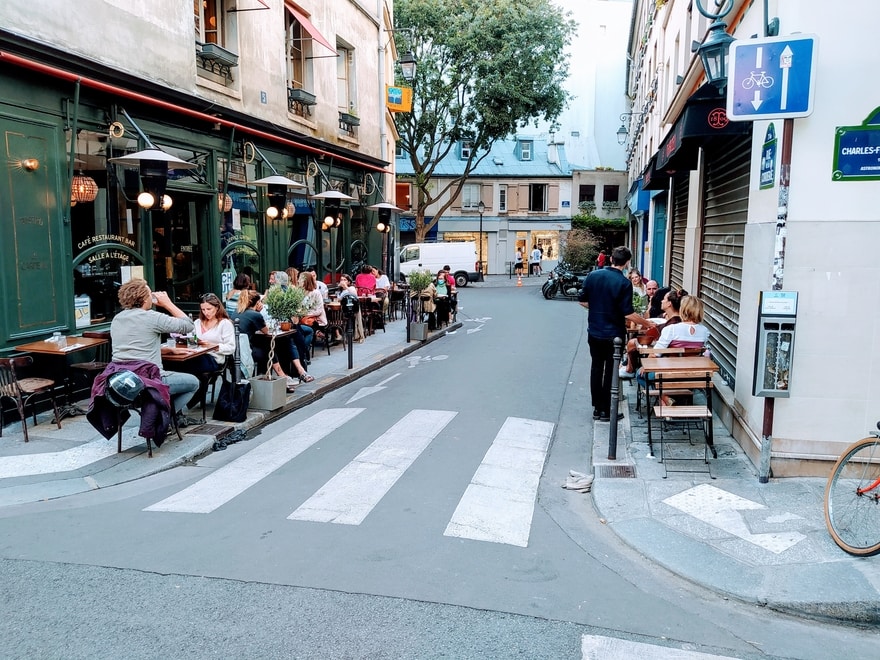
Unfortunately, they haven’t been without controversy. Any business using these new terraces has signed a charter with a list of conditions, including restricting opening hours to between 8 am and 10 pm, leaving a set width for pedestrians to pass, and limiting noise. However, this hasn’t been enough to prevent complaints from residents of neighbouring properties. Often this is because the rules aren’t respected, with bars remaining open after 10 and tables taking up space that should be reserved for pedestrians. I’ve personally witnessed pavements where the space available was far too narrow, with customers having to stand and move chairs to allow wheelchair users through.
Meanwhile, motorists are unhappy with the loss of parking spaces. In addition to the new restaurant terraces, parking has also been removed to create extra space for pedestrians in certain places with narrow pavements, to prevent crowding and allow people to maintain their distance from each other. But car users have other, more pressing, complaints, as we shall see.

Coronapistes: new cycle lanes
More than anything else, one particular policy has drawn attention, not just in Paris but around the world: the creation of coronapistes – coronavirus cycle lanes.
Before the crisis hit, Mayor Hidalgo had already made cycling a central part of her reelection campaign, proposing a “100% cycling” policy1. During her first term in office, Paris’s cycling plan had proposed 300 km of new cycle lanes, or 123 km when considering only dedicated, segregated lanes. This goal was missed by some distance – only 56% of the proposed segregated lanes were completed by April 2020, with 42% “satisfactory” according to cycling association Paris en Selle – but the end result was still a huge improvement on the 2014 situation, a fact this organisation recognised.
Against this backdrop, the coronavirus crisis came along and proved a catalyst for rapid change. The eight weeks of full lockdown gave Parisians a glimpse of what the city looks like when not dominated by cars. The air was clearer, the streets more pleasant and the sounds of nature more audible. At the same time, the need to limit crowding on public transport meant that once people began to head back to work, alternatives had to be found – and it was vital to ensure people didn’t turn to private cars.
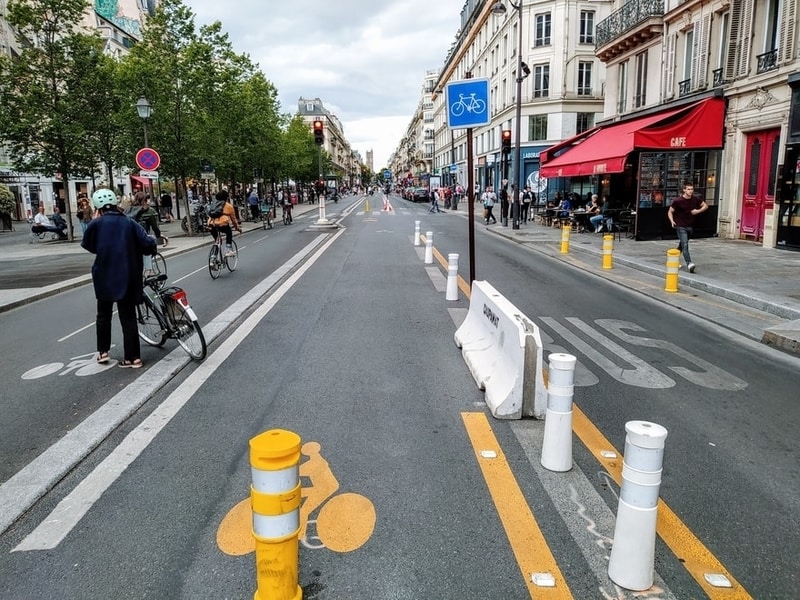
The urgency of the circumstances allowed the local government to act more quickly than would normally be possible, creating 50 km of new cycle lanes by removing car lanes and parking. Meanwhile, the rue de Rivoli, which since last year already boasts one of Paris’s best-used segregated two-way cycle lanes, has been completely closed to through motor traffic, with the exception of emergency vehicles, buses and taxis, to create more room for cyclists.
Some of the coronapistes are based on an idea proposed by cycling groups during the municipal election campaign: “Vélopolitain”, in which the city’s main metro lines are doubled above ground by cycle paths. It’s a simple idea, but a powerful one: the metro network provides a basic, easy-to-understand framework for the key routes across Paris. Temporary cycle lanes have been installed above lines 1, 4 and 13 of the metro, three of the system’s most-frequented lines.
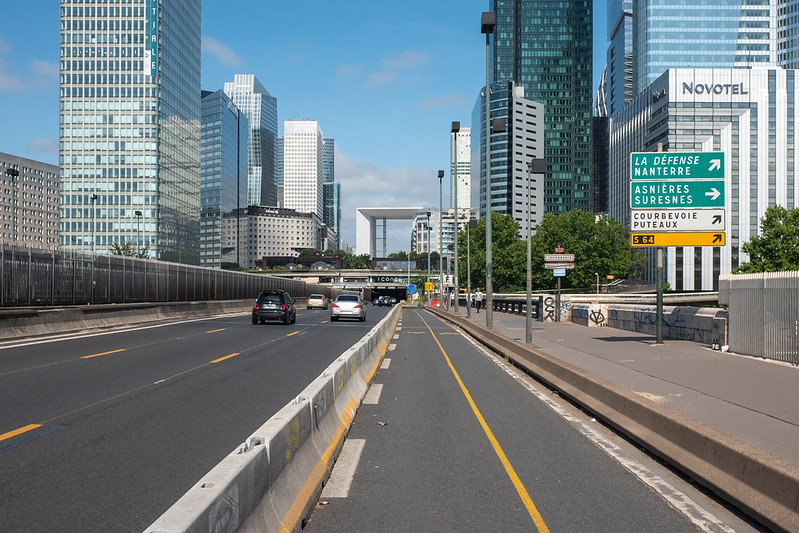
New cycle lanes within Paris are great, but what about the rest of the region? Anne Hidalgo’s jurisdiction only covers the inner core of 2.1 million inhabitants and 105 km², with the urban area extending far beyond the city limits. Fortunately, some of the suburbs were quicker to mobilise even than Paris itself. The northeastern suburban département of Seine-Saint-Denis has created 86 km of coronapistes; Val-de-Marne in the south east has added 40 km, mostly following major public transport routes; and Hauts-de-Seine in the west has created 40 km, again largely along transit axes.
It’s striking that these three councils, respectively led by the centre-left, the far-left and the right, have all taken similar measures. But they haven’t been without controversy. Motorist organisation Rouler Libre has lodged a complaint with the Council of State against road closures in Paris, while the mayor of the town of Drancy has launched a petition against a cycle lane installed by Seine-Saint-Denis along a major road through the town. And last month, during the debates ahead of the second round of the municipal election, rival Agnès Buzyn had a specific complaint (largely debunked) about a coronapiste along the rue de Sèvres.
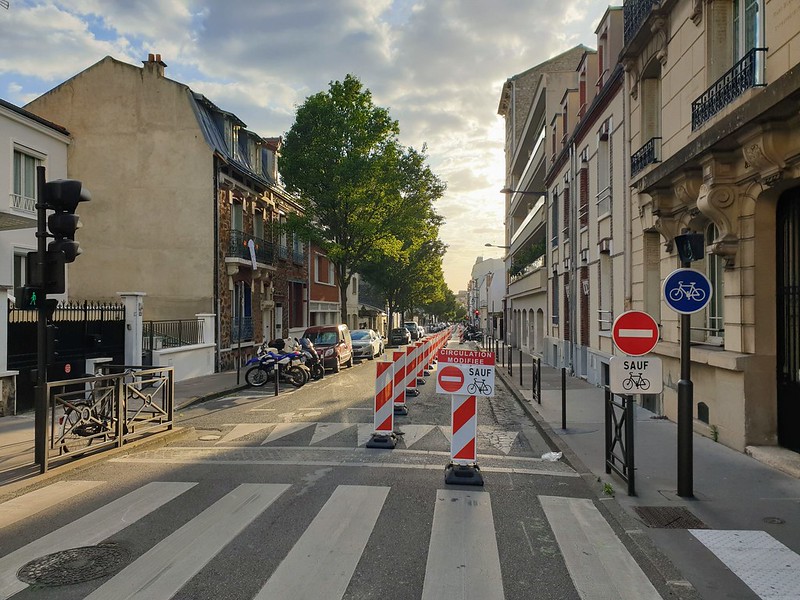
Buzyn’s main point was that this cycle lane had been installed without significant consultation, in particular with the local hospital (whose main entrance is on the road in question). She touched on something important here. Popup bike lanes and street terraces are classic examples of tactical urbanism. This philosophy breaks away from cities’ traditionally long and arduous consultation processes, which can be a serious obstacle to real change. These processes can also be opaque to those not well-versed in local politics, excluding people from decision-making. Flipping the usual order on its head, tactical urbanist projects start by installing cheap, temporary infrastructure, reacting to local feedback before making it permanent in a future iteration. For instance, in the case of the rue de Sèvres cycle lane, any negative feedback from the hospital would be taken into account before making it permanent. (According to Libération, no such feedback has been given in this case).
Hidalgo wants to make all of Paris’s coronapistes permanent. Her council might do well to listen to any feedback to ensure these permanent routes have widespread support. Likewise, some people have called for some of the restaurant terraces to remain long-term. It seems clear that they can’t all stay in their current form: some of those delivery spots might need to be reclaimed, cluttered pavements given back to pedestrians, and noise complaints from residents considered. But with permanent infrastructure to protect pedestrians, cyclists and the roadway, and new safeguards against problems with noise, perhaps some of them could be allowed to remain.
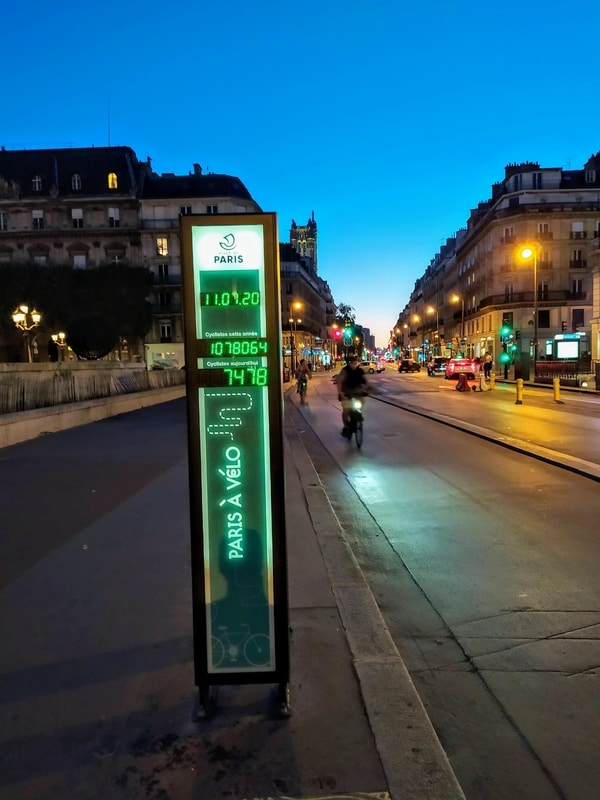
Breaking records
The numbers of cyclists on Paris’s streets keep breaking records. We had already seen historic highs last December, when a once-in-a-generation strike drastically reduced metro service for weeks. But during the epidemic, the figures have reached delirious new highs. A counter on the rue de Rivoli, next to the Hôtel de Ville, was counting 14000 cyclists a day in mid-June, and it’s been consistently above 10000. Last autumn, this number hovered around 2000. My personal experience supports the statistics: several of my colleagues have recently taken to cycling to and from work from the suburbs. I cross the boulevard de Sébastopol every day and witness an impressive stream of bikes. And after a shambolic rollout in 2018 after a change of contract, public cycle hire scheme Vélib’ is now back in people’s good books, seeing record ridership in June.
Covid-19 has killed thousands of people in the Paris region and hundreds of thousands worldwide. Lockdowns around the world have caused huge economic headaches, bringing real hardship to even greater numbers. And yet many cities, Paris a leader among them, have found the silver lining: having seen what things look like when we are no longer ruled by cars, they are determined to avoid a return to business as usual.
-
The term 100% vélo is intended to mean that 100% of streets will be safe and convenient to cycle on. But I’m not convinced it’s an effective term, as it’s easily misunderstood. Hidalgo’s main opponents misinterpreted it as meaning everyone should cycle, and (I believe disingenuously) pointed out that elderly and disabled people and parents of small children might not be able to cycle. ↩
 Fabric of Paris
Fabric of Paris